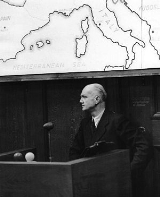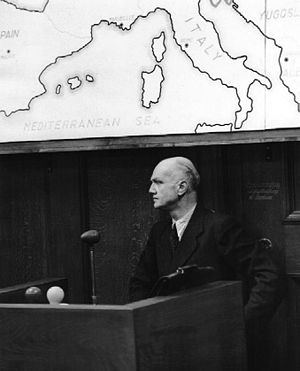
Erwin von Lahousen
Encyclopedia

Abwehr
The Abwehr was a German military intelligence organisation from 1921 to 1944. The term Abwehr was used as a concession to Allied demands that Germany's post-World War I intelligence activities be for "defensive" purposes only...
official during World War II
World War II
World War II, or the Second World War , was a global conflict lasting from 1939 to 1945, involving most of the world's nations—including all of the great powers—eventually forming two opposing military alliances: the Allies and the Axis...
, as well as a member of the German Resistance
German Resistance
The German resistance was the opposition by individuals and groups in Germany to Adolf Hitler or the National Socialist regime between 1933 and 1945. Some of these engaged in active plans to remove Adolf Hitler from power and overthrow his regime...
and a key player in attempts to assassinate Adolf Hitler
Adolf Hitler
Adolf Hitler was an Austrian-born German politician and the leader of the National Socialist German Workers Party , commonly referred to as the Nazi Party). He was Chancellor of Germany from 1933 to 1945, and head of state from 1934 to 1945...
on March 13, 1943 and July 20, 1944.
Background
An AustriaAustria
Austria , officially the Republic of Austria , is a landlocked country of roughly 8.4 million people in Central Europe. It is bordered by the Czech Republic and Germany to the north, Slovakia and Hungary to the east, Slovenia and Italy to the south, and Switzerland and Liechtenstein to the...
n from an aristocratic family, Lahousen served in the Austro-Hungarian Army
Austro-Hungarian Army
The Austro-Hungarian Army was the ground force of the Austro-Hungarian Dual Monarchy from 1867 to 1918. It was composed of three parts: the joint army , the Austrian Landwehr , and the Hungarian Honvédség .In the wake of fighting between the...
during World War I
World War I
World War I , which was predominantly called the World War or the Great War from its occurrence until 1939, and the First World War or World War I thereafter, was a major war centred in Europe that began on 28 July 1914 and lasted until 11 November 1918...
. After the war, he became member of Austrian counterintelligence. However, after the Anschluss
Anschluss
The Anschluss , also known as the ', was the occupation and annexation of Austria into Nazi Germany in 1938....
in 1938, Austria's intelligence services were absorbed into Germany's, and Lahousen joined the Abwehr
Abwehr
The Abwehr was a German military intelligence organisation from 1921 to 1944. The term Abwehr was used as a concession to Allied demands that Germany's post-World War I intelligence activities be for "defensive" purposes only...
, headed by Admiral Wilhelm Canaris
Wilhelm Canaris
Wilhelm Franz Canaris was a German admiral, head of the Abwehr, the German military intelligence service, from 1935 to 1944 and member of the German Resistance.- Early life and World War I :...
.
World War II
The men took well to each other, as both shared anti-NaziNazism
Nazism, the common short form name of National Socialism was the ideology and practice of the Nazi Party and of Nazi Germany...
feelings. Lahousen became a member of a circle of hand-picked officers opposed to Hitler who ran the intelligence agency. Canaris appointed him chief of Abwehr section II, which dealt primarily with sabotage
Sabotage
Sabotage is a deliberate action aimed at weakening another entity through subversion, obstruction, disruption, or destruction. In a workplace setting, sabotage is the conscious withdrawal of efficiency generally directed at causing some change in workplace conditions. One who engages in sabotage is...
.
Lahousen handled the successful sabotage aspects of the invasion of Poland
Invasion of Poland (1939)
The Invasion of Poland, also known as the September Campaign or 1939 Defensive War in Poland and the Poland Campaign in Germany, was an invasion of Poland by Germany, the Soviet Union, and a small Slovak contingent that marked the start of World War II in Europe...
in September 1939. But because Canaris did not give as much a priority to sabotage as to espionage
Espionage
Espionage or spying involves an individual obtaining information that is considered secret or confidential without the permission of the holder of the information. Espionage is inherently clandestine, lest the legitimate holder of the information change plans or take other countermeasures once it...
, Lahousen ordered that agents destined for Britain
United Kingdom
The United Kingdom of Great Britain and Northern IrelandIn the United Kingdom and Dependencies, other languages have been officially recognised as legitimate autochthonous languages under the European Charter for Regional or Minority Languages...
be trained primarily for spying, with disastrous results
Double Cross System
The Double Cross System, or XX System, was a World War II anti-espionage and deception operation of the British military intelligence arm, MI5. Nazi agents in Britain - real and false - were captured, turned themselves in or simply announced themselves and were then used by the British to broadcast...
. Saboteurs who landed in the United States
United States
The United States of America is a federal constitutional republic comprising fifty states and a federal district...
during Operation Pastorius
Operation Pastorius
Operation Pastorius was a failed plan for sabotage via a series of attacks by Nazi German agents inside the United States. The operation was staged in June 1942 and was to be directed against strategic U.S. economic targets...
in June 1942 were betrayed to the FBI by one of their number, arrested, tried by military tribunal, and executed.
In 1943, Lahousen was sent to the Eastern Front
Eastern Front (World War II)
The Eastern Front of World War II was a theatre of World War II between the European Axis powers and co-belligerent Finland against the Soviet Union, Poland, and some other Allies which encompassed Northern, Southern and Eastern Europe from 22 June 1941 to 9 May 1945...
and thus escaped the final days of the Abwehr, which, along with Canaris, had fallen into disfavor. Lahousen later claimed that he was the one who supplied the bomb used on the Smolensk plot (Operation Spark, March 13, 1943
Operation Spark (1940)
Operation Spark was a plan generated in the early 1940s by German anti-Nazis to assassinate Adolf Hitler. Another Operation Spark was conducted by the Red Army during the siege of Leningrad in 1943....
). The assassination attempt carried out by Fabian von Schlabrendorff
Fabian von Schlabrendorff
Fabian Ludwig Georg Adolf Kurt von Schlabrendorff , was a German jurist, soldier and member of the resistance against Adolf Hitler....
failed.
After the failure of the assassination attempt and putsch (20 July plot), Claus von Stauffenberg and thousands of other accused plotters, including Canaris, were executed. Due to his service at the front, Lahousen escaped notice.
On July 19, 1944 Lahousen was heavily wounded by an artillery hit.
Nuremburg Trial
After the end of the war, Lahousen voluntarily testified against Hermann GöringHermann Göring
Hermann Wilhelm Göring, was a German politician, military leader, and a leading member of the Nazi Party. He was a veteran of World War I as an ace fighter pilot, and a recipient of the coveted Pour le Mérite, also known as "The Blue Max"...
and 21 other defendants at the Nuremberg War Crimes Trials in 1945–1946. Lahousen was the first witness for the prosecution, his prominence due to being the sole survivor of the 'Abwehr resistance'. Among other things, he gave evidence about the murder of hundreds of thousands of Soviet prisoners of war
Prisoner of war
A prisoner of war or enemy prisoner of war is a person, whether civilian or combatant, who is held in custody by an enemy power during or immediately after an armed conflict...
and the Einsatzgruppen
Einsatzgruppen
Einsatzgruppen were SS paramilitary death squads that were responsible for mass killings, typically by shooting, of Jews in particular, but also significant numbers of other population groups and political categories...
death squads, who liquidated more than a million Jews
Jews
The Jews , also known as the Jewish people, are a nation and ethnoreligious group originating in the Israelites or Hebrews of the Ancient Near East. The Jewish ethnicity, nationality, and religion are strongly interrelated, as Judaism is the traditional faith of the Jewish nation...
in the conquered areas of the Soviet Union
Soviet Union
The Soviet Union , officially the Union of Soviet Socialist Republics , was a constitutionally socialist state that existed in Eurasia between 1922 and 1991....
, Poland and the Ukraine.
Primary source
This article is based on the book of- Karl Glaubauf and Stefanie Lahousen-Vivremont. Generalmajor Erwin Lahousen-Edler von Vivremont. Ein Linzer Abwehroffizier im militärischen Widerstand, LIT-Verlag, Münster 2005, ISBN 3-8258-7259-9

